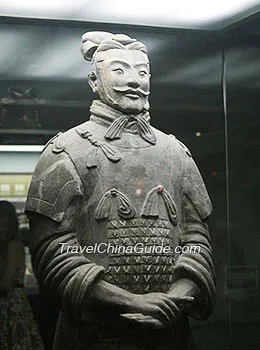The terracotta officers wear distinctive headgear, dual or single-layer knee-length gowns, pants, a pair of shoes, and are covered with a piece of colorful armor, looking grand and awe-inspiring. Most terracotta soldiers also wear a knee-length gown, a piece of armor, a hat or hood, pants and shoes or boots. Some soldiers do not wear armor; they fight in light equipment.
What Are the Terracotta Officers Wearing?
Headgear
Almost all of the terracotta officers were made with a flat bun covered by distinctive headgear. Some headgear in a length of 15 cm (6 inches) or so have an approximately oblong shape with a bending back part; some have a trapezoid shape; and some of the headgear have a twisted back part like a pheasant’s tail. In real life, their material was leather or multi-layered waxed cloth. The headgear were mainly in ochre or vermilion. There are strings tied on each side of the headgear to fix it on the warrior’s head.
 See detailed Headgear of Terracotta Warriors
See detailed Headgear of Terracotta Warriors
Knee-length Gown and Long Pants
As for clothes, a majority of terracotta warriors wear knee-length gowns. However, some superior officers were fabricated with dual-layer gowns, and other officers wear single-layer gowns. Both the single-layer and dual-layer coats have the same configuration with long sleeves. Observing the officer warriors closely, it is easy to find that nearly all of them are in long pants.
Almost all the terracotta officers were covered by armor with a smooth edge and colorful lace, which is used to protect them in battle. The armor of different-ranked officers is differs.
In real life, armor for superior officers was made of leather. The front of the armor was below the warrior’s chest, and there were some small plates stitched on the armor at the back waist. Colored drawings and patterns were painted on the armor where there was no plate, and you could also find several knots made with colorful laces on the armor. Some of the superior officers’ armor had a shoulder protector and some did not.
There are two different styles of armor used for junior officers. One is the chest-armor coat with braces, which has shoulder pads and no back and and would have been made of a single piece of leather in the
Qin Dynasty (221 BC – 207 BC). In the center of the leather are eleven rows of plates. We can see exquisite geometric patterns drawn on its braces. The second style is a colorful scale armor coat covering front and back sides as well as shoulder pads. As its name indicates, many small square scale plates are linked together on the leather to assemble a complete armor.
Ordinary officers wear an unlaced armor coat. This armor is assembled from hundreds of brown-black plates. Its front side is longer than the back side, and there are no patterns painted on the armor.
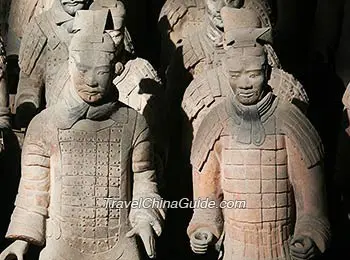 | | Middle and Lower Rank Terracotta Officers | | 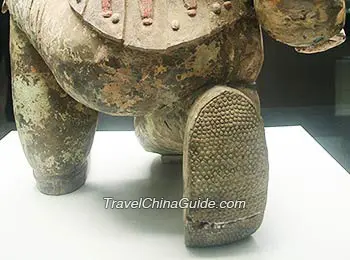 | | Shoe Sole with Stitches | |
All of the unearthed terracotta officers wear shoes, which have basically the same boat-shaped appearance with a thin sole, low sides, and a curled toecap. In addition, the shoe soles are distinctive because they have dense stitches on the front and heel parts to resist skidding, and sparse stitches on the arch to ensure comfort, hence they are reputed as the “earliest outdoor shoes”.
What Are Terracotta Soldiers Wearing?
Qin soldiers are equipped with a hat or hood. The bowl-shaped hat for
terracotta cavalry warriors has a domed top and a short forepart, while the trailing edge of the hat is long, and there is a white peach blossom pattern carved in its middle back; according to historical records, they were made of deerskin in real life. Most soldiers wear a conical soft hood to cover their chignons. It was made with a single layer soft cloth. The color of the hood is mostly vermilion. In some cases, soldiers wear neither hat nor hood, only a hair band is used to fix their chignons.
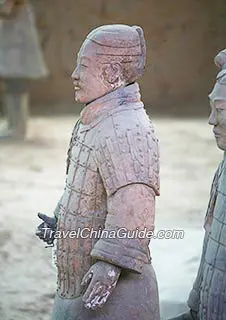 | | Dressing of a Cavalry Soldier | | 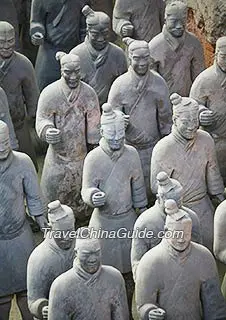 | | Terracotta Soldiers | | 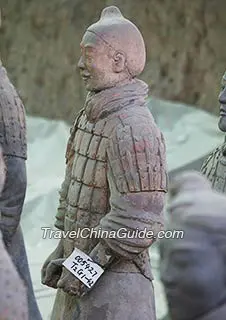 | | The Soldier Wearing a Hood | |
Mostly Knee-length Gowns and Short Pants
Nearly all soldiers wear knee-length gowns and short pants. However, the cavalry soldiers wear Hu dress ("Hu" refers to the northern minorities living in the northwestern part of ancient China) and long pants. Unlike the loose clothes worn by the people living in central China at that time, Hu dress was tight which was easy for horse racing and archery.
Armor
Compared to terracotta officers, soldiers wore relatively simple armor coats which were made of plates only. The plates on the armor are larger and the quantity is less. The armor worn by terracotta soldiers have front sides and back sides as well. In general, they can also be divided into two types: with and without shoulder pads. Many of the soldiers do not have armor.
Most terracotta soldiers wear shoes while a few wear boots. The shoes are similar to those of officers but the toecaps are less curved. Boots are a symbol of Hu dress, with thin soles, round toecaps and short tops; they were mostly for cavalry warriors.

Recommended Tour Itinerary:
Terracotta Warriors Tour: One-day to visit Terracotta Warriors and Horses and more
More
Xi'an Tours  Next: True Colors of Terracotta Warriors
Next: True Colors of Terracotta Warriors
- Last updated on Aug. 04, 2025 by Alex Jin -
![]() See detailed Headgear of Terracotta Warriors
See detailed Headgear of Terracotta Warriors